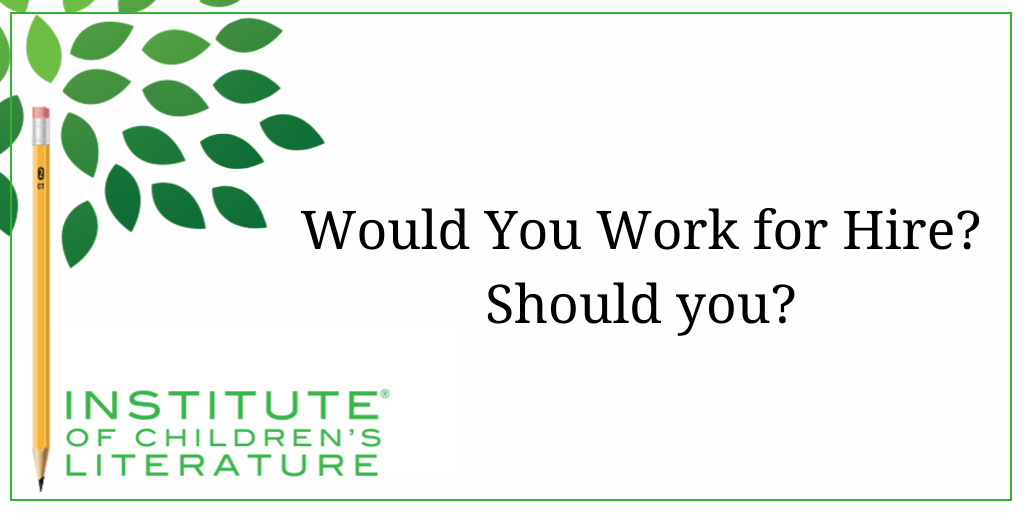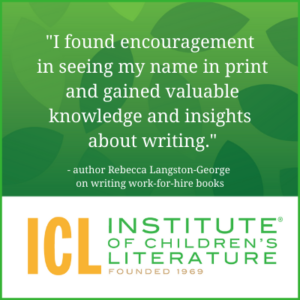
5 Ways Writers Can Prep for 2025 Goal Setting
Before we roll on to the new writing year, let’s harness our optimism for the blank slate before us and prepare for our 2025 Goal Setting just for writers.

We teach our students how to write and get published!
View our Course Catalog >
For many writers seeking steady money for their writing skill, work for hire offers opportunities that are often easier to break into. Most work-for-hire writing opportunities are based on your skills, not your previous publishing credits, making this one way to break into book publishing without the struggle of finding an agent or luring interest in your idea. In this type of project, the publisher hires a writer to create a book instead of being offered a book for possible publication by an author or an agent.
Work-for-hire opportunities are often linked with educational publishing, but they also exist in more traditional commercial publishing. If you see licensed character books (such as books with recognizable super heroes or books based on popular children’s television programming) most of these books were written as work for hire and these books can appear in both traditional commercial publishing and educational publishers. Mass market books such as lift-the-flap books or things like coloring books are also often work for hire and are usually done by commercial publishers who sell in markets like Walmart or Costco. Also traditional commercial publishing sometimes hires writers on a work-for-hire basis to continue a series when reader interest remains but the original writer no longer wants to stay on the project.

The topics for nonfiction books usually originate with the publisher and authors are offered the opportunity to write the book that the publisher needs. Often these nonfiction books are crafted based on very clear and specific formats.
Fiction work for hire with educational publishers sometimes begins with an idea by a publisher, but sometimes begin with writers who pitch ideas. For example, my own series with Abdo about cryptid hunting began as an idea I came up with, and I was only bound by the general format needs of their chapter book line. On the other hand, my series with Abdo featuring pirates began when an editor told me they’d like to see a proposal for a pirate series for their hi/lo line. So I came up with the series specifics, but the idea (pirates) was theirs, and I had to work within their hi/lo format requirements.
One of the ways that work for hire is different from the kind of publishing we most often think about is that payment is made as a flat fee with no royalties (most of the time). The benefit of this is that it’s much easier to budget when you know exactly how much money you’ll be making. The drawback is that there is no bonus if the book becomes extremely popular.
There are few runaway best sellers that come from work-for-hire books, but it is not impossible. I’ve known writers whose work-for-hire, mass market book literally sold millions of copies, but the writer never made more than the few hundred they were paid when they turned in the manuscript. For this reason, some people feel work-for-hire contracts are unfair, but keep in mind that this kind of bestseller is really quite rare.
Another difference with doing books as work-for-hire projects is that everything about the book is the property of the publisher. This means that if the publisher abandons a series, the writer cannot then decide to continue it as a self-published book, because the writer doesn’t own the book characters, premise, or pretty much anything about it. This can be frustrating if readers contact a writer, begging for more books in a series, but the publisher isn’t interested. Extending the series is simply not something the writer can legally do.
On top of this, some work-for-hire contracts have non-compete clauses. These clauses limit what the author can do in other, unrelated books. I’ve seen non-compete clauses that say I won’t work for a competing publisher on books in the same genre, or age group. These kinds of rules in a contract can seriously damage a writer’s potential income so it is extremely important to understand everything in a contract before signing it. Give these things some thought, because after the contract is signed, your options are far more limited.
Work-for-hire contracts are not all identical. Some offer both a flat fee and royalties (this is rare, but not unheard of). Some offer the flat fee but limit the amount of rights the publisher is claiming (again, not often. Usually the publisher claims all rights under copyright, but I have heard of variations). Some have non-compete clauses, and some have nondisclosure clauses. A nondisclosure clause limits what you can say about your experience with the book. Sometimes you cannot even admit to having written it! Again, contracts must be read carefully, understood, and signed only if you’re comfortable with what is being offered.
Most work-for-hire contracts have fairly tight deadlines. If you’re the sort of writer who can write strong prose quickly, then these kinds of projects can be a very lucrative sideline to your own original books. If you’re the sort of writer who writes slowly, then this is probably not an area that you will enjoy. You should also be sure that you don’t find the work creatively draining. If you have no energy left for your own original books, work for hire can become a career trap, providing plenty of money but less satisfaction. So the question of whether this way of making money with your writing will work for you is entirely dependent on you, and on your goals and your style. I like work for hire, even though it is sometimes frustrating. Give it some thought. Maybe you will too.
With over 100 books in publication, Jan Fields writes both chapter books for children and mystery novels for adults. She’s also known for a variety of experiences teaching writing, from one session SCBWI events to lengthier Highlights Foundation workshops to these blog posts for the Institute of Children’s Literature. As a former ICL instructor, Jan enjoys equipping writers for success in whatever way she can.

Before we roll on to the new writing year, let’s harness our optimism for the blank slate before us and prepare for our 2025 Goal Setting just for writers.

Writers can be thin-skinned when it comes to getting feedback on their work. Let’s look at 4 ways to positively deal with constructive criticism!

Rejection is part of the territory when it comes to being a writer. Today we offer reflection for writers to help redirect your efforts after a rejection.
1000 N. West Street #1200, Wilmington, DE 19801
© 2024 Direct Learning Systems, Inc. All rights reserved.
1000 N. West Street #1200, Wilmington, DE 19801
© 2024 Direct Learning Systems, Inc. All rights reserved.
1000 N. West Street #1200, Wilmington, DE 19801
© 2024 Direct Learning Systems, Inc. All rights reserved.
1000 N. West Street #1200, Wilmington, DE 19801
© 2024 Direct Learning Systems, Inc. All rights reserved.

1000 N. West Street #1200, Wilmington, DE 19801
© 2025 Direct Learning Systems, Inc. All rights reserved.

1000 N. West Street #1200, Wilmington, DE 19801
©2025 Direct Learning Systems, Inc. All rights reserved. Privacy Policy.
5 Comments
As the writer of more than 150 work-for-hire books, I really enjoyed reading this article. I started my writing career with my own projects and found the rejection letters to be very deflating after a while. I love the flexibility of doing work-for-hire projects and also the stability of knowing that when I finish a manuscript, it will make its way into the hands of young readers and I will also get a paycheck at the end. While some people may find WFH projects less creative, I always enjoy the research and finding ways to put my own stamp on the books I write — whether through interesting sidebars, helping to suggest images, etc.
Hi Alicia. Sounds like you and I are on the same path. Thanks so much for posting.